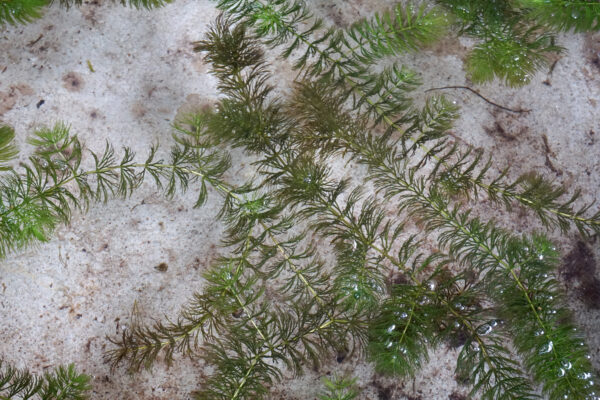
Species at a Glance
Hydrilla verticillata is a submerged, aquatic, perennial plant that grows and spreads at a very fast rate covering the surface of water bodies and restricting boating, fishing, swimming, and other recreational uses. Hydrilla is a federally listed noxious weed, and so it is illegal to possess, distribute, or transport Hydrilla in the United States.
Species Description
Hydrilla is an aggressively growing perennial plant that roots itself to the bottom of lakes and other waterbodies at depths of up to 12 ft (3.7 m). Its long, branching stems reach up to the water’s surface, where it quickly spreads and takes over.
Hydrilla leaves occur in whorls of 3-8, are typically strap-like, and are pointed with small sharp teeth on the edge. Spines or conical bumps may be found on the midvein on the underside of the leaf, making it rough to the touch. Hydrilla can be found in two forms: dioecious, meaning that male and female structures are found on separate plants, and monoecious, meaning a single plant can have both male and female structures. During the late growing season, generally September-October, small white tubers form on the roots of Hydrilla. These tubers store food and enable the plant to over-winter.
Native & Introduced Ranges
Most likely native to Korea, Hydrilla was introduced into the United States in the 1950s. While the dioecious form appears to spread only south of South Carolina, the monoecious form is spreading both north and south and is the only form found in Pennsylvania. In Pennsylvania, Hydrilla was first reported in the mid-1990s in Adams and Bradford counties and has since been identified in at least 25 counties spanning the entire state. Currently, Antarctica is the only continent without records of Hydrilla.
Biology & Spread
Both forms of Hydrilla have been introduced in the United States, most likely as aquarium plants. Once released, it easily spread across the United States through freshwater recreational activities such as boating and fishing. Hydrilla reproduces primarily vegetatively; even the smallest living plant fragment can float downstream and form a new plant. This makes it easy for pieces of Hydrilla stuck on boat motors, trailers, live wells, or bait buckets to start new infestations. Tubers
are also a key component of reproduction and spread as they can remain dormant in the sediment for several years before growing new plants.
Habitat
Hydrilla is able to grow in a wide variety of still and flowing water settings such as freshwater lakes, ponds, rivers, impoundments, and canals. It tolerates a wide range of pH, nutrient, and light levels. Hydrilla is somewhat winter-hardy; however, the optimum temperature for growth is 68-81°F (20-27°C).
Impacts
Threat to Biodiversity
This invasive plant is characterized by its ability to grow quickly and form dense thick mats at the water surface. Under ideal conditions, Hydrilla can grow up to 2.5 cm (1 in) per day, per stem! These mats prevent sunlight from penetrating into the water and effectively shade out other species growing beneath. As the mats die and decay, bacteria deplete oxygen from the water. Hydrilla can also displace native plant life and shift balanced ecosystems to monocultures, which can alter populations of native fish and other wildlife.
Economic Costs
Hydrilla interferes with both commercial and recreational freshwater activities and can have an expensive impact. Thick mats can hinder agricultural and hydroelectric power production by reducing irrigation flow rates by up to 90 percent and by
clogging water intake pipes and filters. Hydrilla impairs recreational activities like swimming, fishing, water skiing, and boating. Heavy growth can entangle and clog propellers, requiring frequent cleanings to travel even short distances.
Prevention & Control
Hydrilla is difficult to eradicate. Most popular methods of control include the use of herbicides in combination with biocontrol. Contact herbicides can provide temporary control, while systemic herbicides, which are absorbed and spread throughout the plant, provide more long-term control but tend to act slowly. Herbivorous fish have been used for Hydrilla
control where allowed by law. Mechanical aquatic weed harvesters are used to temporarily open boating lanes, but the resulting plant fragments can spread vegetation faster and is therefore not recommended.
To prevent the spread of Hydrilla, always remove all visible mud and plants before leaving a water body. Eliminate water from all equipment before transporting to new locations. Clean gear and equipment with either hot water (104°F or 40°C), or salt water OR let dry thoroughly for five days before entering a new water body. Hydrilla is listed as a federal noxious weed, making it illegal to possess, distribute, or transport.
References:
True-Meadows, S; Haug, E.J; and Richardson, R.J. 2013. Monoecious Hydrilla-A review of the Literature. Journal of Aquatic Plant Management. 54:1-11.
The University of Georgia, USDA Forest Service, & USDA APHIS PPQ. 2003. Invasive Plants of the Eastern United States: Hydrilla.
Posey, MH; Wigand, C; Stevenson, JC. 1993. Effects of an introduced aquatic plant, Hydrilla verticillata, on benthic communities in the upper Chesapeake Bay. Estuarine, Coastal and Shelf Science 37:539-555.



